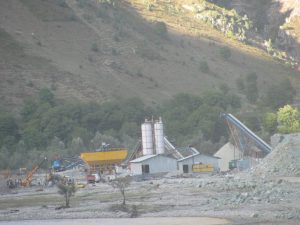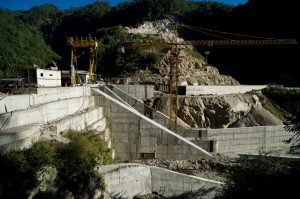Almost a year after its launch by Prime Minister Narendra Modi and French President Francois Hollande on the opening day of the Paris climate summit on November 30, 2015, the International Solar Alliance (ISA) is close to being officially introduced to prospective member countries for signing at the upcoming climate summit.
The Indian government is hopeful that the alliance that aims to expand solar power in tropical and sub-tropical countries will get the required support at the November 7-18 UN climate summit at Marrakech in Morocco. An official in India’s Ministry of New and Renewable Energy told thethirdpole.net that the ISA Cell expects a treaty formalising the alliance to be signed by at least 50 countries.
All details of the treaty have not been finalised yet. It would be “legally binding”, said a ministry official, while another said “it would be a treaty of voluntary commitments” on the lines of the Paris Agreement.
The United States, which supports the alliance that aims at mitigating climate change by boosting solar power, has been cautious about what this legal structure would entail. The US has been pushing for an informal alliance, according to news reports. But an Indian government official said, “It has full support of the US. We need a minimum of 15 countries for ratification. And if all goes well, we hope to have a signing ceremony at the COP (conference of parties to be held in November in Marrakech).”
Sunlit nations
The International Solar Alliance was conceived as a coalition of solar resource-rich countries (that get sunshine on at least 300 days in a year) that lie fully or partially between the Tropic of Cancer and the Tropic of Capricorn. The aim is to help developing countries harness 1,000 GW of solar by 2030 and to help raise USD 1 trillion and associated technological assistance to achieve this goal. USD 500 billion is to come from national governments and public sector companies while the other half is expected to come from the private sector.
Currently 121 countries are members of the alliance, including many developing countries. So far, 37 countries have sent comments on the current working draft about how the alliance should be structured and what it should do. As the convenor, India is working hard to garner support for the alliance globally, and at Marrakech over 50 countries are expected to sign the alliance document, turning it into a legal entity, an Indian official said.
Once the framework is approved, the International Solar Alliance will have a steering committee and an assembly. The steering committee of 22 member nations has already met four times this year and its secretariat has been set up at the National Institute of Solar Energy on the outskirts of New Delhi.
Tremendous interest
At the seventh meeting of the ISA cell that was held on September 7, Piyush Goyal, India’s energy minister, said, “Many countries and organisations including UN organisations and the World Bank have shown tremendous interest in ISA. The membership of ISA need not be restricted to countries situated between the two Tropics and could go beyond 121 members taking other countries as partner countries with the same rights and obligations.”
The biggest challenge for the alliance now is how to deploy large-scale solar power projects at an affordable cost and to provide technology access to developing countries. ISA is to work towards creating an ecosystem of financial instruments to mitigate the investment risks in solar, bring down cost of capital, aggregate demands and promote energy access.
See: India needs to accelerate International Solar Alliance
ISA was launched with a notion that India would assist in mustering finances and technology for other developing countries to develop solar power and it is believed that it can in turn help India in filling the wide gap between its energy demand and supply. Analysts say that it will not only help in research and development in the country but will also help India access solar technologies and finance at much lower transactional cost.
“It will certainly standardise tenders and the market will also increase,” said the government official, who spoke on the condition of anonymity. “It is also laudable that ISA is on the verge of being ratified within just a year of its launch.”
Lack of financial support
However, the problem is that industrialised nations have so far not put forth any significant financial commitments for ISA. France had pledged euro 300 million (USD 333 million) over the next five years but it hasn’t put any money on the table yet. India has pledged USD 15 million as corpus money and provided the five acre plot to house the secretariat. It will also pay the costs of running the secretariat.
See: International Solar Alliance gets a home in India
Various Indian companies and organisations have contributed to the corpus. ISA is also seeking money from the Green Climate Fund. “The proposal is to strive for a USD 300 billion Global Solar Fund over ten years with contributions from the World Bank, ODA and also from Green Climate Fund to leverage USD 3,000 billion investment from the corporate sector for meeting investment requirement for solar energy programmes and projects in the ISA member countries,” according to the minutes of the seventh meeting of the ISA cell.
Environmentalists have welcomed the formation of alliance. They say it has huge potential and can bring down the cost of solar power significantly if executed in the right manner.
Srinivas Krishnaswamy, CEO, Vasudha Foundation, a renewable energy think tank, told thethirdpole.net, “I think anything on renewable energy is good news. Bringing countries together is good news. Having a pool of money for solar deployment, R&D, purchase of patents of some technologies is good. Any alliance is good news.”
“This alliance aims to support many African countries where interest rate of solar is quite high, almost 25%, which makes it impossible to deploy solar,” Chandra Bhushan, Deputy Director General at Centre for Science and Environment, a Delhi-based non-profit, told thethirdpole.net. “I think this institution can be very helpful if it looks into how this cost can be reduced and capacity building. It has huge potential and if it is rightly tapped, it can be a win-win situation.”
Questions raised
Bhushan however questioned the need for a treaty. “I don’t understand how an alliance can be legally binding. How and what kind of targets will the countries agree upon? We already have targets on solar under INDCs (Intended Nationally Determined Contributions). Most countries have not in fact given solar targets in INDCs but renewable energy targets. For instance, India has said 40% of its electricity mix will come from the renewables by 2030. It doesn’t say how much of this will be from solar. So how can this be legally binding? This is an alliance for cooperation and support on solar and it should focus on executing it on the ground.”
So what kind of legally binding commitments will nations take up if ISA ends up as a treaty? While details are still unknown, another senior government official said, “It won’t have any commitments on finance. It will be a treaty of voluntary commitments only that will facilitate aggregation of demand, solar applications, finance, reduction in the cost of borrowing and so on.”
In the meantime, the Indian government is hopeful that once the ISA gets ratified and more countries put in money, it will generate more confidence among investors and many private institutions and businesses will come forward to participate.
![<p>Indian Prime Minister Narendra Modi and French President François Hollande at the inauguration of the International Solar Alliance secretariat [image by: Government of India]</p>](https://dialogue.earth/content/uploads/2016/11/ISA.jpg)







